


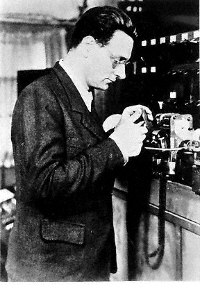 Konrad Zuse
Konrad Zuse
|
1945
Konrad Zuse began work on Plankalkul (Plan Calculus), the first algorithmic
programming language, with an aim of creating the theoretical preconditions for
the formulation of problems of a general nature. Seven years earlier, Zuse had
developed and built the world's first binary digital computer, the Z1. He
completed the first fully functional program-controlled electromechanical
digital computer, the Z3, in 1941. Only the Z4 -- the most sophisticated of
his creations -- survived World War II.
|
|
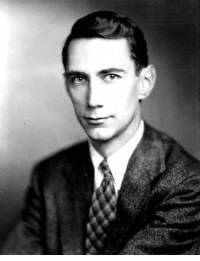 Claude Shannon
Claude Shannon
|
1948
Claude Shannon's "The Mathematical Theory of Communication" showed
engineers how to code data so they could check for accuracy after transmission
between computers. Shannon identified the bit as the fundamental unit of data
and, coincidentally, the basic unit of computation.
|
|
 IBM 701
IBM 701
|
1953
John Backus completed speedcoding for IBM's 701 computer. Although speedcoding
demanded more memory and compute time, it trimmed weeks off of the programming
schedule.
|
|
|
1955
Herbert Simon and Allen Newell unveiled Logic Theorist software that supplied
rules of reasoning and proved symbolic logic theorems. The release of Logic
Theorist marked a milestone in establishing the field of artificial
intelligence.
|
||
|
1956
The first operating system for the IBM 704 reflected the cooperation of Bob
Patrick of General Motors and Owen Mock of North American Aviation. Called
GM-NAA I/O, it allowed batch processing -- a simple way to combine existing
commands into new commands.
|
||
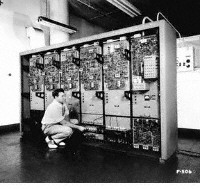 MIT Whirlwind
MIT Whirlwind
|
1956
At MIT, researchers began experimentation on direct keyboard input on
computers, a precursor to today's normal mode of operation. Doug Ross wrote a
memo advocating direct access in February; five months later, the Whirlwind
aided in such an experiment.
|
|
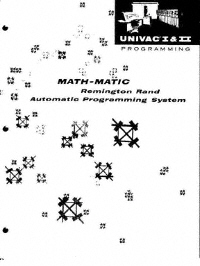 UNIVAC MATH-MATIC
UNIVAC MATH-MATIC
|
1957
Sperry Rand released a commercial compiler for its UNIVAC. Developed by Grace
Hopper as a refinement of her earlier innovation, the A-0 compiler, the new
version was called MATH-MATIC. Earlier work on the A-0 and A-2 compilers led
to the development of the first English-language business data processing
compiler, B-0 (FLOW-MATIC), also completed in 1957. FLOW-MATIC served as a
model on which to build with input from other sources.
|
|
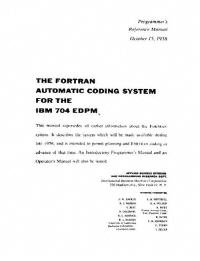 IBM 704 FORTRAN
IBM 704 FORTRAN
|
1957
A new language, FORTRAN (short for FORmula TRANslator), enabled a computer to
perform a repetitive task from a single set of instructions by using loops.
The first commercial FORTRAN program ran at Westinghouse, producing a missing
comma diagnostic. A successful attempt followed.
|
|
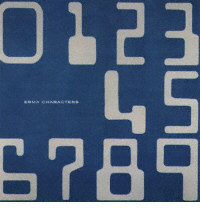 ERMA characters
ERMA characters
|
1959
ERMA, the Electronic Recording Method of Accounting, digitized checking for the
Bank of America by creating a computer-readable font. A special scanner read
account numbers preprinted on checks in magnetic ink.
|
|
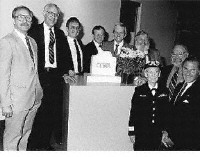 COBOL design team
COBOL design team
|
1960
A team drawn from several computer manufacturers and the Pentagon developed
COBOL, Common Business Oriented Language. Designed for business use, early
COBOL efforts aimed for easy readability of computer programs and as much
machine independence as possible. Designers hoped a COBOL program would run
on any computer for which a compiler existed with only minimal modifications.
Howard Bromberg, an impatient member of the committee in charge of creating COBOL, had this tombstone made out of fear that the language had no future. However, COBOL has survived to this day. |
|
 LISP Programmer's Reference
LISP Programmer's Reference
|
1960
LISP made its debut as the first computer language designed for writing
artificial intelligence programs. Created by John McCarthy, LISP offered
programmers flexibility in organization.
|
|
 SpaceWar! on PDP-1
SpaceWar! on PDP-1
|
1962
MIT students Slug Russell, Shag Graetz, and Alan Kotok wrote SpaceWar!,
considered the first interactive computer game. First played at MIT on DEC's
PDP-1, the large-scope display featured interactive, shoot'em-up graphics that
inspired future video games. Dueling players fired at each other's spaceships
and used early versions of joysticks to manipulate away from the central
gravitational force of a sun as well as from the enemy ship.
|
|
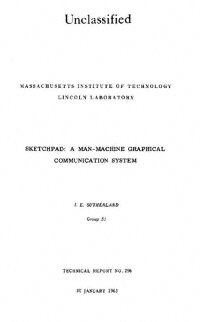 Sketchpad document
Sketchpad document
|
1963
Ivan Sutherland published Sketchpad, an interactive, real time computer drawing
system, as his MIT doctoral thesis. Using a light pen and Sketchpad, a
designer could draw and manipulate geometric figures on the screen.
|
|
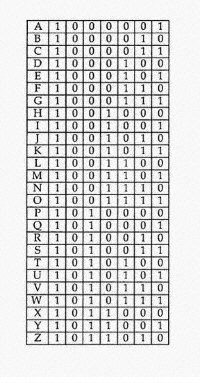 ASCII code
ASCII code
|
1963
ASCII -- American Standard Code for Information
Interchange -- permitted machines from different manufacturers to
exchange data. ASCII consists of 128 unique strings of ones and zeros. Each
sequence represents a letter of the English alphabet, an Arabic numeral, an
assortment of punctuation marks and symbols, or a function such as a carriage
return.
|
|
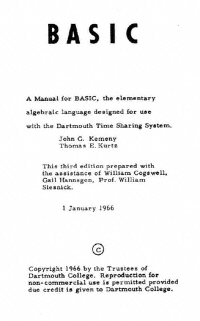 BASIC manual
BASIC manual
|
1964
Thomas Kurtz and John Kemeny created BASIC, an easy-to-learn programming
language, for their students at Dartmouth College.
|
|
|
1965
Object-oriented languages got an early boost with Simula, written by Kristen
Nygaard and Ole-John Dahl. Simula grouped data and instructions into blocks
called objects, each representing one facet of a system intended for
simulation.
|
||
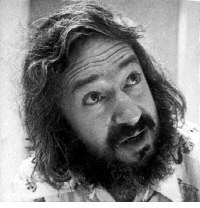 Seymour Papert
Seymour Papert
|
1967
Seymour Papert designed LOGO as a computer language for children. Initially a
drawing program, LOGO controlled the actions of a mechanical
"turtle," which traced its path with pen on paper. Electronic
turtles made their designs on a video display monitor.
Papert emphasized creative exploration over memorization of facts: "People give lip service to learning to learn, but if you look at curriculum in schools, most of it is about dates, fractions, and science facts; very little of it is about learning. I like to think of learning as an expertise that every one of us can acquire." |
|
|
1968
Edsger Dijkstra's "GO TO considered harmful" letter, published in
Communications of the ACM, fired the first salvo in the structured programming
wars. The ACM considered the resulting acrimony sufficiently harmful that it
established a policy of no longer printing articles taking such an assertive
position against a coding practice.
[Full text]
|
||
|
1969
The RS-232-C standard for communication permitted computers and peripheral
devices to transmit information serially -- that is, one bit at a time. The
RS-232-C protocol spelled out a purpose for a serial plug's 25 connector pins.
|
||
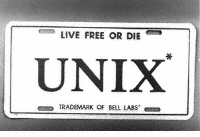 UNIX "license plate"
UNIX "license plate"
|
1969
AT&T Bell Laboratories programmers Kenneth Thompson and Dennis Ritchie
developed the UNIX operating system on a spare DEC minicomputer. UNIX combined
many of the timesharing and file management features offered by Multics, from
which it took its name. (Multics, a projects of the mid-1960s, represented the
first effort at creating a multi-user, multi-tasking operating system.) The
UNIX operating system quickly secured a wide following, particularly among
engineers and scientists.
|
|
|
1972
Nolan Bushnell introduced Pong and his new company, Atari video games.
|
||
 CP/M
CP/M
|
1976
Gary Kildall developed CP/M, an operating system for personal computers.
Widely adopted, CP/M made it possible for one version of a program to run on a
variety of computers built around eight-bit microprocessors.
|
|
|
1977
The U.S. government adopted IBM's data encryption standard, the key to
unlocking coded messages, to protect confidentiality within its agencies.
Available to the general public as well, the standard required an eight-number
key for scrambling and unscrambling data. The 70 quadrillion possible
combinations made breaking the code by trial and error unlikely.
|
||
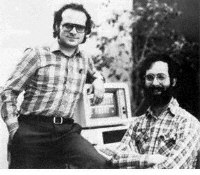 Bob Frankston and Dan Brinklin
Bob Frankston and Dan Brinklin
|
1979
Harvard MBA candidate Daniel Bricklin and programmer Robert Frankston developed
VisiCalc, the program that made a business machine of the personal computer,
for the Apple II. VisiCalc (for Visible Calculator) automated
the recalculation of spreadsheets. A huge success, more than 100,000 copies
sold in one year.
|
|
|
1981
The MS-DOS, or Microsoft Disk Operating System, the basic software for the
newly released IBM PC, established a long partnership between IBM and
Microsoft, which Bill Gates and Paul Allen had founded only six years earlier.
|
||
 Lotus 1-2-3
Lotus 1-2-3
|
1982
Mitch Kapor developed Lotus 1-2-3, writing the software directly into the
video system of the IBM PC. By bypassing DOS, it ran much faster than its
competitors. Along with the immense popularity of the IBM's computer, Lotus
owed much of its success to its working combination of spreadsheet capabilities
with graphics and data retrieval capabilities.
Kapor, who received his bachelor's degree in an individually designed cybernetics major from Yale University in 1971, started Lotus Development Corp. to market his spreadsheet and served as its president and CEO from 1982 to 1986. He also has worked to develop policies that maximize openness and competitiveness in the computer industry. |
|
|
1983
Microsoft announced Word, originally called Multi-Tool Word, and Windows. The
latter doesn't ship until 1985, although the company said it would be on track
for an April 1984 release. In a marketing blitz, Microsoft distributed 450,000
disks demonstrating its Word program in the November issue of PC World
magazine.
|
||
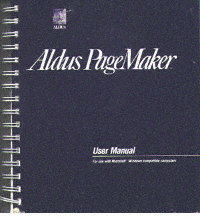 Aldus PageMaker
Aldus PageMaker
|
1985
Aldus announced its PageMaker program for use on Macintosh computers, launching
an interest in desktop publishing. Two years later, Aldus released a version
for IBMs and IBM-compatible computers. Developed by Paul Brainerd, who founded
Aldus Corp., PageMaker allowed users to combine graphics and text easily enough
to make desktop publishing practical.
Chuck Geschke of Adobe Systems Inc., a company formed in 1994 by the merger of Adobe and Aldus, remembered: "John Sculley, a young fellow at Apple, got three groups together - Aldus, Adobe, and Apple - and out of that came the concept of desktop publishing. Paul Brainerd of Aldus is probably the person who first uttered the phrase. All three companies then took everybody who could tie a tie and speak two sentences in a row and put them on the road, meeting with people in the printing and publishing industry and selling them on this concept. The net result was that it turned around not only the laser printer but, candidly, Apple Computer. It really turned around that whole business." |
|
|
1985
The C++ programming language emerged as the dominant object-oriented language
in the computer industry when Bjarne Stroustrup published "The C++
Programming Language." Stroustrup, at AT&T Bell Laboratories, said
his motivation stemmed from a desire to write event-driven simulations that
needed a language faster than Simula. He developed a preprocessor that allowed
Simula style programs to be implemented efficiently in C.
Stroustrup wrote in the preface to "The C++ Programming Language": "C++ is a general purpose programming language designed to make programming more enjoyable for the serious programmer. Except for minor details, C++ is a superset of the C programming language. In addition to the facilities provided by C, C++ provides flexible and efficient facilities for defining new types.... The key concept in C++ is class. A class is a user-defined type. Classes provide data hiding, guaranteed initialization of data, implicit type conversion for user-defined types, dynamic typing, user-controlled memory management, and mechanisms for overloading operators.... C++ retains C's ability to deal efficiently with the fundamental objects of the hardware (bits, bytes, words, addresses, etc.). This allows the user-defined types to be implemented with a pleasing degree of efficiency." |
||
|
1987
Apple engineer William Atkinson designed HyperCard, a software tool that
simplifies development of in-house applications. HyperCard differed from
previous programs of its sort because Atkinson made it interactive rather than
language-based and geared it toward the construction of user interfaces rather
than the processing of data. In HyperCard, programmers built stacks with the
concept of hypertext links between stacks of pages. Apple distributed the
program free with Macintosh computers until 1992.
Hypercard users could look through existing HyperCard stacks as well as add to or edit the stacks. As a stack author, a programmer employed various tools to create his own stacks, linked together as a sort of slide show. At the lowest level, the program linked cards sequentially in chronological ordered, but the HyperTalk programming language allowed more sophisticated links. |
||
|
1989
Maxis released SimCity, a video game that helped launch of series of
simulators. Maxis cofounder Will Wright built on his childhood interest in
plastic models of ships and airplanes, eventually starting up a company with
Jeff Braun and designing a computer program that allowed the user to create his
own city. A number of other Sims followed in the series, including SimEarth,
SimAnt, and SimLife.
In SimCity, a player starts with an untouched earth. As the mayor of a city or city planner, he creates a landscape and then constructs buildings, roads, and waterways. As the city grows, the mayor must provide basic services like health care and education, as well as making decisions about where to direct money and how to build a revenue base. Challenges come in the form of natural disasters, airplane crashes, and monster attacks. |
||
|
1989
The concept of virtual reality made a statement as the hot topic at Siggraph's
1989 convention in Boston. The Silicon Graphics booth featured the new
technology, designed by the computer-aided design software company Autodesk and
the computer company VPL. The term describes a computer-generated 3-D
environment that allows a user to interact with the realities created there.
The computer must calculate and display sensory information quickly enough to
fool the senses.
Howard Rheingold described, "shared and objectively present like the physical world, composable like a work of art, and as unlimited and harmless as a dream." First practical for accomplishing such tasks as flight simulation, virtual reality soon spread much further, promising new ground in video games, education, and travel. Computer users are placed into the virtual environment in a variety of ways, from a large monitor to a head-mounted display or a glove. |
||
|
1990
Microsoft shipped Windows 3.0 on May 22. Compatible with DOS programs, the
first successful version of Windows finally offered good enough performance to
satisfy PC users. For the new version, Microsoft revamped the interface and
created a design that allowed PCs to support large graphical applications for
the first time. It also allowed multiple programs to run simultaneously on its
Intel 80386 microprocessor.
Microsoft released Windows amid a $10 million publicity blitz. In addition to making sure consumers knew about the product, Microsoft lined up a number of other applications ahead of time that ran under Windows 3.0, including versions of Microsoft Word and Microsoft Excel. As a result, PCs moved toward the user-friendly concepts of the Macintosh, making IBM and IBM-compatible computers more popular. |
|
|
|
Copyright | Privacy | Feedback